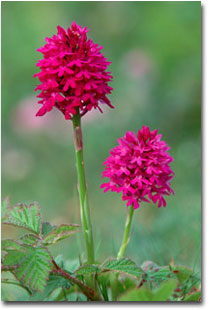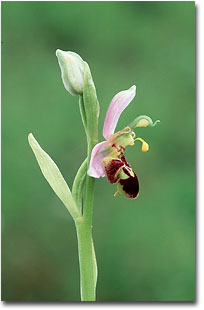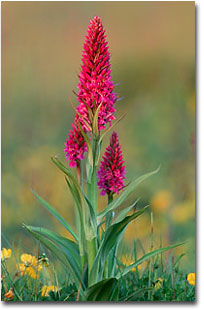|
|
 The Orchids of the Peak District National Park
Text and photography Copyright Geoff Simpson
With some degree of imagination, orchids can remind you of butterflies, bees, flies and frogs. They are, by any standards, a fabulous collection even if all are small-flowered and somewhat inconspicuous and of interest only to botanists and those interested in orchids. The flora of the “Peak” would be, undoubtedly, poorer without them. Their bizarre lifestyle has encouraged the belief that they are fabulously rare and delicate. A few undoubtedly are rare, with only one or two sites throughout the region, while several species are widely distributed and commonplace at favoured localities. Take a casual walk around Miller’s Dale in June and July and one cannot help, but notice the hundreds of spikes of pink, and occasionally, white of the Common Spotted Orchids, which line the pathways and grassland. If you look carefully, you will see bee orchids and the diminutive frog orchid flourish on the quarry floor. By mid July the appearance, of the vanilla scented Fragrant Orchids replace those earlier flowering species. However, just a stone’s throw away from the village of Peakdale, there exists an expanse of damp grassland and meadow where some of the regions orchid species occur in such vast numbers that you could be misled into thinking they were common species. Over ninety thousand Southern-Marsh and Common Spotted Orchids and hybrids make an impressive site. There are regularly over three thousand bee orchids and several hundred frog orchids, plus the thousands of twayblade which flourish in this damp meadow. A handful of the locally rare Early-Marsh Orchids thrive amidst the delicate ivory-coloured blooms of uncommon grass-of-parnassus.
There seem to be several reasons for this new adaptability. Orchids produce huge quantities of exceptionally small and lightweight seeds that can be carried long distances on the wind and often settle on the new, artificial habitats. The only reason orchids haven’t become as common as docks and sorrels in such places is the result of the one undeniably delicate feature of orchids – their seeds are so small that they barely have enough food inside them to survive on their own. Most species rely on forming a co-operative partnership with an underground fungus resulting in a dual organism known as a mycorrhiza. The fungus, deeply embedded in the growing seeds, supplies it with the necessary food and minerals in its early stages although it has come to light that some species continue this relationship throughout the their entire lives. The orchid seedling returns the compliment once it has green leaves and is manufacturing its own food. Orchids belonging the family helleborine develop without the need for such a co-operative partnership. The most modest of these confident new colonisations has been the invasion of churchyards by the reclusive Broad-Leaved Helleborine. The Pyramidal Orchid, so called for the conical shape of its magenta flower heads, used to be an indicator of ancient grasslands. It is now cropping up in increasingly improbable habitats. It has recently colonised waste from mineral extraction at Middleton Moor and wasteland at Peakdale. The regions most widespread orchid, the Twayblade, often goes unnoticed, unlike its more colourful relation, Common Spotted Orchid which also haunts roadside verges. This expansion is rapidly occurring along with its closely related cousin the Southern-Marsh Orchid at disused quarries and spoils tips. The individual flowers of this group can be almost any colour from white to deep purple. Hybridisation among these species is commonplace. In fact, at some sites, finding a non-hybridised specimen is something of a rarity. Although British orchids generally occupy rather specialised habitats, few species can be said to be common and, even among so-called abundant species, the numbers do fluctuate enormously from one year to another. Undoubtedly, there seems to be no limit to the enterprise of orchids.
Many orchid species favour calcareous grassland, a habitat that has been severely reduced by intensive farming methods and conversion into arable farmland. Chemical fertilisers, herbicides and the re-seeding of meadows and pastures have all helped to reduce the number of orchids. Effective communication between landowners and conservationists is important to minimise such destruction. In some circumstances, secrecy about the locality of rare orchid species is justified, but if the users of land are not aware of what grows there, disaster can result. Legislation has started to play an important role in protecting individual plants and preserving sites from development. The Wildlife and Countryside Act 1981 contains a schedule of plants that can be legally protected from picking, uprooting or destruction. Currently there are over ninety scheduled plants of which ten are orchid species. How effective this legislation continues to be depends to a considerable extent on the understanding and sympathy of the landowners and tenants. Effective protection measures, whether they are imposed by law or not, require knowledge of the biology of the plants at risk and their interactions with the environment. Ecological research is, therefore, vital to the conservation of rare pants and indeed, to the prevention of commoner species becoming rare. Perhaps the most important element in halting the decline of these beautiful and often rare plants is education. Although the orchids found within the “Peak District” generally occupy rather specialised habitats, few species can be said to be common and even among so-called common species, the numbers fluctuate enormously from one year to another.
Other orchid species occurring within the Peak District include: Fly Orchid (most northerly location in Britain) With regards to photographing orchids and wildflowers, I essentially employ 3 simple techniques on a regular basis. For wide-angle environmental type images, I use my Canon 24mm lens wide-angle or 45mm Tilt & shift lenses to ensure a strong foreground element dominates the resulting image. For close-up intimate views of the flowers heads, I engage my Canon 180mm macro lens with my tried and trusted Canon EOS-1n mounted on a low tripod or, more often than not, a beanbag. Using a long telephoto lens in the region of 200mm to 500mm and fitting a 25mm extension tube, I am able to attain portrait images of the entire plant. This techniques not only helps isolate the plant from the surrounding vegetation, it also allows for the arrangement of a reasonable working distance thus, reflectors can easily be arranged. When using long lenses in terms of orchid photography, I tend to use a beanbag, which provides a solid support, and the Canon Angle-Finder C saves cricking my neck. GS - NPN 230 Comments on this article? Send them to the editor. |
||||||||||||||||||||||
|
|
 Summer heralds some of the most beautiful and truly fascinating flora the British countryside has to offer and orchids represent our most glamorous and highly regarded wildflowers. In most people’s mind the term “orchid” portrays an exotic flower of tropical forests, not of British wildflowers that grow on damp meadows, bogs, limestone scree slopes and grasslands. It may surprise many people, therefore, that Britain can boast around 50 or so species of which 16 species occur within the boundaries of the world’s most visited national park the “Peak District”. The region is divided into two distinct regions-the “Dark Park” where the predominant rock is Millstone Grit. The "White Peak" is where limestone and basalt outcrops are the geological formations that give this region of the Peak District its name. Despite their image as fragile rarities, most of Britain’s native orchids are survivors, whose exquisite summer blooms redeem the wasteland that is their unlikely habitat.
Summer heralds some of the most beautiful and truly fascinating flora the British countryside has to offer and orchids represent our most glamorous and highly regarded wildflowers. In most people’s mind the term “orchid” portrays an exotic flower of tropical forests, not of British wildflowers that grow on damp meadows, bogs, limestone scree slopes and grasslands. It may surprise many people, therefore, that Britain can boast around 50 or so species of which 16 species occur within the boundaries of the world’s most visited national park the “Peak District”. The region is divided into two distinct regions-the “Dark Park” where the predominant rock is Millstone Grit. The "White Peak" is where limestone and basalt outcrops are the geological formations that give this region of the Peak District its name. Despite their image as fragile rarities, most of Britain’s native orchids are survivors, whose exquisite summer blooms redeem the wasteland that is their unlikely habitat.  These rare species may well be prized but something unexpected has happened to many of our other orchid species. They are showing an inclination to become opportunists-canny and adaptable freeloaders. As their traditional habitats in the countryside of hay-meadows, ancient woods have been destroyed or reduced in size, so they began to pop up in man-made equivalents of these places. Road verges are substituted for pastures, steep-sided limestone quarries for meadows. Orchids have invaded even the lime rich chemical wastelands of quarries. It is a true modern myth, a kind of botanical beauty and the beast, with the exquisite blooms redeeming the ugly spoil heap.
These rare species may well be prized but something unexpected has happened to many of our other orchid species. They are showing an inclination to become opportunists-canny and adaptable freeloaders. As their traditional habitats in the countryside of hay-meadows, ancient woods have been destroyed or reduced in size, so they began to pop up in man-made equivalents of these places. Road verges are substituted for pastures, steep-sided limestone quarries for meadows. Orchids have invaded even the lime rich chemical wastelands of quarries. It is a true modern myth, a kind of botanical beauty and the beast, with the exquisite blooms redeeming the ugly spoil heap. Despite there tenacious tendencies, all British Orchids are constantly under threat from a number of factors. Habitat destruction is a major concern and changes to the use of agricultural land has probably been responsible more than anything else, for the decline of many of our native orchids and other wildflowers.
Despite there tenacious tendencies, all British Orchids are constantly under threat from a number of factors. Habitat destruction is a major concern and changes to the use of agricultural land has probably been responsible more than anything else, for the decline of many of our native orchids and other wildflowers.